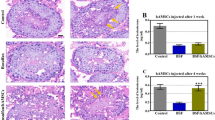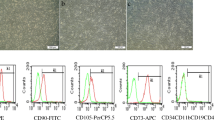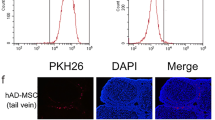Abstract
Today, infertility affects 15% of couples and half of this rate is due to reproductive problems in men. Radiation-induced damage to the testicles causes sterility depending on the dose. Radiation causes endoplasmic reticulum (ER) stress and ER stress induces apoptosis. In this study, the effect of human amniotic membrane-derived mesenchymal stem cells (hAMSCs) and conditioned medium (hAMSCs-CM) on testicular damage induced by ionizing radiation is aimed to be elucidated through ER stress and apoptosis mechanisms. Six gray scrotal irradiation was used to create a testicular injury model. hAMSCs isolated and characterized with immunofluorescence and flow cytometry, while 2.5 × 105 hAMSCs were transplanted into testis and hAMSCs-CM was applied. Fertility assessment was performed. Expressions of ER stress markers GRP78, Ire1, Chop and Caspase-12, and Caspase-3 were determined. TUNEL was performed. Serum FSH, LH, and testosterone were measured. After hAMSC transplantation and administration of hAMSCs-CM, offsprings were obtained. Seminiferous tubule diameter and seminiferous epithelial height increased. The expression of GRP78, IRE1α, CHOP, Caspase-12, and Caspase-3 decreased. Percentages of tunel positive cells decreased. While FSH and LH levels decreased, testosterone increased. After irradiation, both hAMSCs transplantation and paracrine activity of hAMSCs may have a role in reducing ER stress by suppressing the UPR response. Decrease in FSH and LH and increase in testosterone level after MSCs transplantation may have contributed to the improvement of spermatogenesis. Thus, it can be said that MSCs derived from human amniotic membrane can improve ionized radiation-induced testicular damage by reducing ER stress and apoptosis.





Similar content being viewed by others
Data Availability
The data that support the findings of this study are available from the corresponding author upon reasonable request.
References
Kleiman SE, Yogev L, Gamzu R, et al. Genetic evaluation of infertile men. Hum Reprod. 1999;14:33–8. https://doi.org/10.1093/humrep/14.1.33.
Simon L, Emery BR, Carrell DT. Review: diagnosis and impact of sperm DNA alterations in assisted reproduction. Best Pract Res Clin Obstet Gynaecol. 2017;44:38–56.
Larson KL, DeJonge CJ, Barnes AM, et al. Sperm chromatin structure assay parameters as predictors of failed pregnancy following assisted reproductive techniques. Hum Reprod. 2000;15:1717–22. https://doi.org/10.1093/humrep/15.8.1717.
Wasilewski-Masker K, Seidel KD, Leisenring W, et al. Male infertility in long-term survivors of pediatric cancer: a report from the childhood cancer survivor study. J Cancer Surviv. 2014;8:437–47. https://doi.org/10.1007/s11764-014-0354-6.
Howell SJ. Spermatogenesis after cancer treatment: damage and recovery. J Natl Cancer Inst Monogr. 2005;2005:12–7. https://doi.org/10.1093/jncimonographs/lgi003.
Oeffinger KC, Nathan PC, Kremer LCM. Challenges After Curative Treatment for Childhood Cancer and Long-Term Follow up of Survivors. Pediatr Clin North Am. 2008;55:251–73.
Wang M, Kaufman RJ. Protein misfolding in the endoplasmic reticulum as a conduit to human disease. Nature. 2016;529:326–35.
Han J, Back SH, Hur J, et al. ER-stress-induced transcriptional regulation increases protein synthesis leading to cell death. Nat Cell Biol. 2013;15:481–90. https://doi.org/10.1038/ncb2738.
Volarevic V, Bojic S, Nurkovic J, et al. Stem cells as new agents for the treatment of infertility: current and future perspectives and challenges. Biomed Res Int. 2014;2014:507234.
Can A. Kök Hücre: biyolojisi, türleri ve tedavide kullanımları. Akademisyen Tıp Kitabevi, Ankara. 2014
Kinnaird T, Stabile E, Burnett MS, et al. Local delivery of marrow-derived stromal cells augments collateral perfusion through paracrine mechanisms. Circulation. 2004;109:1543–9. https://doi.org/10.1161/01.CIR.0000124062.31102.57.
Vellasamy S. Isolation and characterisation of mesenchymal stem cells derived from human placenta tissue. World J Stem Cells. 2012;4:53. https://doi.org/10.4252/wjsc.v4.i6.53.
Alviano F, Fossati V, Marchionni C, et al. Term amniotic membrane is a high throughput source for multipotent mesenchymal stem cells with the ability to differentiate into endothelial cells in vitro. BMC Dev Biol. 2007;7:11. https://doi.org/10.1186/1471-213X-7-11.
Cetinkaya B, Unek G, Kipmen-Korgun D, et al. Effects of human placental amnion derived mesenchymal stem cells on proliferation and apoptosis mechanisms in chronic kidney disease in the rat. Int J Stem Cells. 2019;12:151–61. https://doi.org/10.15283/ijsc18067.
Bentzen SM. Preventing or reducing late side effects of radiation therapy: radiobiology meets molecular pathology. Nat Rev Cancer. 2006;6:702–13.
Soncini M, Vertua E, Gibelli L, et al. Isolation and characterization of mesenchymal cells from human fetal membranes. J Tissue Eng Regen Med. 2007;1:296–305. https://doi.org/10.1002/term.40.
Zhang Q, Bu S, Sun J, et al. Paracrine effects of human amniotic epithelial cells protect against chemotherapy-induced ovarian damage. Stem Cell Res Ther. 2017;8:270. https://doi.org/10.1186/s13287-017-0721-0.
Cargnoni A, Ressel L, Rossi D, et al. Conditioned medium from amniotic mesenchymal tissue cells reduces progression of bleomycin-induced lung fibrosis. Cytotherapy. 2012;14:153–61. https://doi.org/10.3109/14653249.2011.613930.
Kim J, Park J-C, Kim S-H, et al. Treatment of FGF-2 on stem cells from inflamed dental pulp tissue from human deciduous teeth. Oral Dis. 2014;20:191–204. https://doi.org/10.1111/odi.12089.
Akan E, Cetinkaya B, Kipmen-Korgun D, et al. Effects of amnion derived mesenchymal stem cells on fibrosis in a 5/6 nephrectomy model in rats. Biotech Histochem. 2021. https://doi.org/10.1080/10520295.2021.1875502.
Akpolat M, Oz ZS, Gulle K, et al. X irradiation induced colonic mucosal injury and the detection of apoptosis through PARP-1/p53 regulatory pathway. Biomed Pharmacother. 2020;127:110134. https://doi.org/10.1016/j.biopha.2020.110134.
Adiguzel D, Sahin P, Kuscu N, et al. Spatiotemporal expression and regulation of FoxO1 in mouse uterus during peri-implantation period. PLoS ONE. 2019;14:e0216814. https://doi.org/10.1371/JOURNAL.PONE.0216814.
Türk E, Tekeli IO, Özkan H, et al. The protective effect of esculetin against aluminium chloride-induced reproductive toxicity in rats. Andrologia. 2021;53:e13930. https://doi.org/10.1111/AND.13930.
Díaz-Prado S, Muiños-López E, Hermida-Gómez T, et al. Multilineage differentiation potential of cells isolated from the human amniotic membrane. J Cell Biochem. 2010;111:846–57. https://doi.org/10.1002/JCB.22769.
Miyamoto T, Tsujimura A, Miyagawa Y, et al. Male infertility and its causes in human. Adv Urol. 2012;2012:384520.
Chen H, Tang QL, Wu XY, et al. Differentiation of human umbilical cord mesenchymal stem cells into germ-like cells in mouse seminiferous tubules. Mol Med Rep. 2015;12:819–28. https://doi.org/10.3892/mmr.2015.3528.
Ghasemzadeh-Hasankolaei M, Sedighi-Gilani M, Eslaminejad M. Induction of ram bone marrow mesenchymal stem cells into germ cell lineage using transforming growth factor-β superfamily growth factors. Reprod Domest Anim. 2014;49:588–98. https://doi.org/10.1111/rda.12327.
Huang P, Lin LM, Wu XY, et al. Differentiation of human umbilical cord Wharton’s jelly-derived mesenchymal stem cells into germ-like cells in vitro. J Cell Biochem. 2009. 109:n/a-n/a. https://doi.org/10.1002/jcb.22453.
Cakici C, Buyrukcu B, Duruksu G, et al. Recovery of fertility in azoospermia rats after injection of adipose-tissue-derived mesenchymal stem cells: the sperm generation. Biomed Res Int. 2013;2013:1–18. https://doi.org/10.1155/2013/529589.
Sharma P, Parmar J, Verma P, Goyal PK (2011) Radiation-induced testicular injury and its amelioration by tinospora cordifolia (an Indian medicinal plant) extract. Evidence-based Complement Altern Med 2011. https://doi.org/10.1155/2011/643847.
Chiu H-W, Fang W-H, Chen Y-L, et al. Monascuspiloin enhances the radiation sensitivity of human prostate cancer cells by stimulating endoplasmic reticulum stress and inducing autophagy. PLoS ONE. 2012;7:e40462. https://doi.org/10.1371/journal.pone.0040462.
Motegi S-I, Sekiguchi A, Uchiyama A, et al Protective effect of mesenchymal stem cells on the pressure ulcer formation by the regulation of oxidative and endoplasmic reticulum stress. Sci Rep. 2017. https://doi.org/10.1038/s41598-017-17630-5.
Hu L, Wang H, Huang L, et al. Crosstalk between autophagy and intracellular radiation response (Review). Int J Oncol. 2016;49:2217–26.
Harding HP, Zhang Y, Bertolotti A, et al. Perk is essential for translational regulation and cell survival during the unfolded protein response. Mol Cell. 2000;5:897–904. https://doi.org/10.1016/S1097-2765(00)80330-5.
Kim I, Xu W, Reed JC. Cell death and endoplasmic reticulum stress: disease relevance and therapeutic opportunities. Nat Rev Drug Discov. 2008;7:1013–30. https://doi.org/10.1038/nrd2755.
Malhotra JD, Kaufman RJ. Endoplasmic reticulum stress and oxidative stress: a vicious cycle or a double-edged sword? Antioxidants Redox Signal. 2007;9:2277–93.
Kesavardhana S, Subbarao Malireddi RK, Kanneganti T-D. Annual review of immunology caspases in cell death, inflammation, and pyroptosis. 2020. https://doi.org/10.1146/annurev-immunol-073119.
Stukenborg JB, Jahnukainen K, Hutka M, Mitchell RT. Cancer treatment in childhood and testicular function: the importance of the somatic environment. Endocr Connect. 2018;7:R69-87.
Abd Allah SH, Pasha HF, Abdelrahman AA, Mazen NF. Molecular effect of human umbilical cord blood CD34-positive and CD34-negative stem cells and their conjugate in azoospermic mice. Mol Cell Biochem. 2017;428:179–91. https://doi.org/10.1007/s11010-016-2928-2.
Funding
This study was supported by Research Foundation of Zonguldak Bulent Ecevit University, Turkey (project number: 2018–98210206-03).
Author information
Authors and Affiliations
Contributions
Busra Cetinkaya-Un: conceptualization, methodology, validation, investigation, data collection, writing.
Burak Un: investigation, data collection.
Meryem Akpolat: conceptualization, methodology, validation, control, supervisor.
Fundagul Andic: creation of rat testicular injury model.
Yusufhan Yazır: control, supervisor.
Corresponding author
Ethics declarations
Ethics Approval
This study was approved by Zonguldak Bulent Ecevit University Clinical Research Ethics Committee (File number: 2018-188-12/09) and was conducted in accordance with the principles of the Helsinki Declaration.
The study was approved by the Animal Care and Use Committee of Cukurova University (File number 2018.07.2019/06) and followed the guidelines of the International Association for the Study of Pain.
Conflict of Interest
The authors declare no competing interests.
Rights and permissions
About this article
Cite this article
Cetinkaya-Un, B., Un, B., Akpolat, M. et al. Human Amnion Membrane-Derived Mesenchymal Stem Cells and Conditioned Medium Can Ameliorate X-Irradiation-Induced Testicular Injury by Reducing Endoplasmic Reticulum Stress and Apoptosis. Reprod. Sci. 29, 944–954 (2022). https://doi.org/10.1007/s43032-021-00753-6
Received:
Accepted:
Published:
Issue Date:
DOI: https://doi.org/10.1007/s43032-021-00753-6




